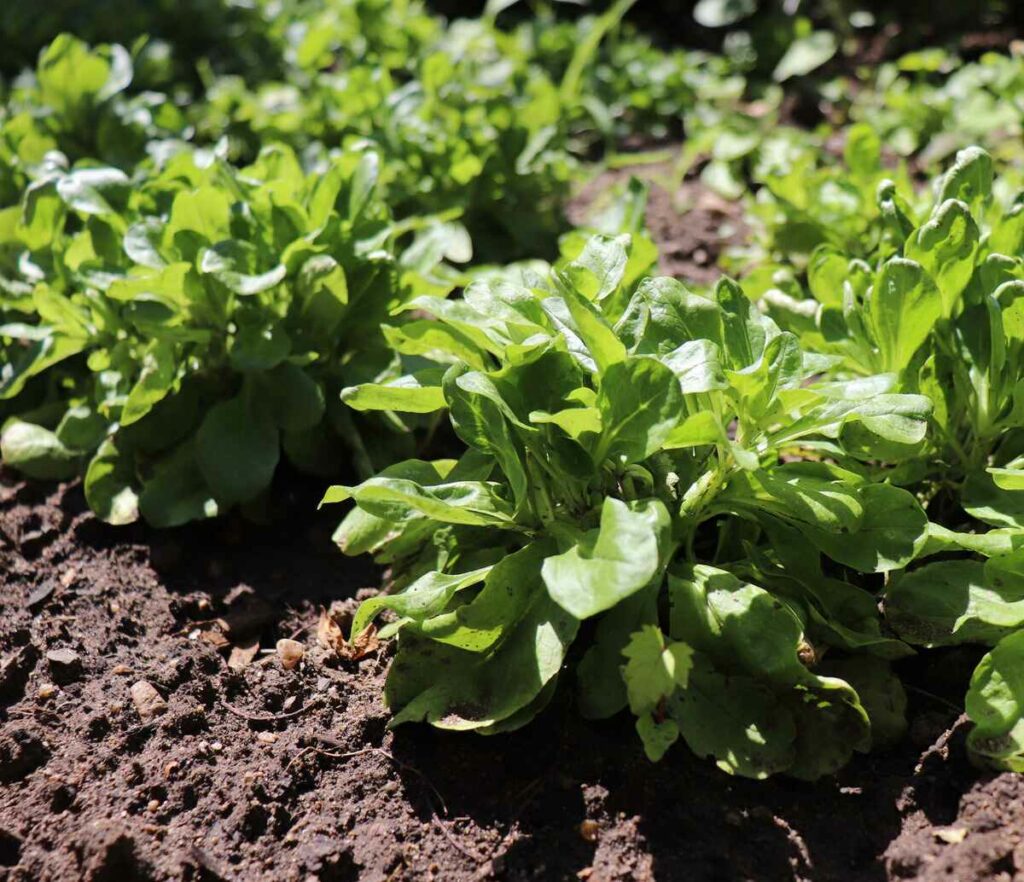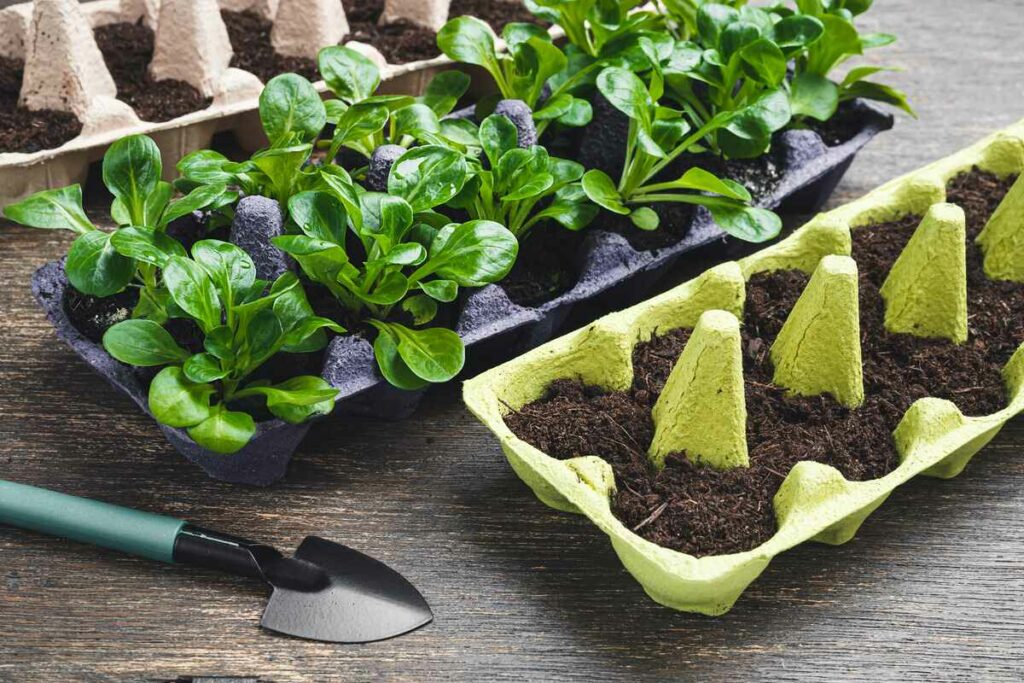Are you tired of the same old salad greens during the winter months? Look no further than trying to grow lambs lettuce, also known as corn salad or mache.
This hardy and delicious crop is perfect for growing throughout the winter, providing you with fresh and flavorful greens even when the weather outside is frightful.
In this article, we will provide you with all the information you need to successfully grow and harvest lamb’s lettuce. From sowing to caring for and harvesting, we’ve got you covered.
With our tips and tricks, you’ll be able to enjoy the nutty and slightly sweet flavor of lamb’s lettuce all winter long. So, let’s get started and discover how to grow flavourful lamb’s lettuce all winter long!

Grow Lambs Lettuce Takeaways
- Lamb’s lettuce is a hardy and flavorful crop that can be grown throughout the winter.
- It is a great alternative to traditional salad greens and can be grown in open soil, pots, or raised beds.
- To ensure success, moisten the soil or compost prior to sowing seeds and cover with a cloche in cooler months.
- Effective pest control techniques include checking for aphids regularly, using copper strips to deter slugs and snails, and using natural remedies such as garlic spray to repel pests.
Characteristics and Benefits
You’ll love to grow lambs lettuce for its unique characteristics and benefits. This low-growing salad crop features small, dark green leaves with a slightly nutty flavor, making it a delicious addition to any salad.
One of the best things about lamb’s lettuce is that it’s hardy and available in winter, making it an excellent alternative to traditional salad greens. Winter gardening can be challenging, but lamb’s lettuce is a great option for those who want to continue growing salad greens throughout the colder months.
This crop slows down its growth in autumn to maintain succulent and flavorful leaves, ensuring that you have fresh, delicious greens all winter long. Additionally, lamb’s lettuce can be grown as a catch crop, meaning that you can sow seeds every two weeks for a continual harvest.
With its hardiness and unique flavor, growing lamb’s lettuce is a great way to add variety to your winter garden.
Grow Lambs Lettuce Tips
To ensure success in cultivating lamb’s lettuce all winter long, it’s important to start by moistening the soil or compost prior to sowing seeds from spring to summer.
In cooler months, cover the seeds with a cloche to aid germination and growth. Remember to sow every two weeks for a continual crop.
Lamb’s lettuce can be grown in open soil, pots, raised beds or even grown together with other leafy greens indoors. If you’re interested in winter gardening, consider container gardening.
Give ample space as it grows slowly and keep the soil or compost moist. Remove annual weeds and protect seedlings from slugs and snails.
With these tips, you’ll be able to enjoy flavourful lamb’s lettuce all winter long.

Pest Control and Harvesting
Protect your lamb’s lettuce from pests such as aphids, slugs, and snails, and harvest the leaves as needed for fresh and tasty salads.
Effective techniques for pest control include checking for aphids regularly and using a strong spray of water to dislodge them, placing copper strips around the plants to deter slugs and snails, and using a natural remedy such as a garlic spray to repel pests.
When harvesting, pick the outer leaves first, leaving the inner ones to continue growing. This will allow the plant to produce more leaves for future harvests.
Remember to wash the leaves thoroughly before consuming and enjoy the unique, nutty flavor of your homegrown lamb’s lettuce.
With proper care and attention, you can have a continual crop of this delicious and hardy salad throughout the winter months.
Frequently Asked Questions
What is the nutritional value of lamb’s lettuce?
Lamb’s lettuce, also known as corn salad or mache, is a low-growing salad crop with small, dark green leaves and a slightly nutty flavor. This winter-hardy plant is a great option for those looking to harvest fresh greens during the colder months.
In terms of health benefits, lamb’s lettuce is packed with vitamins A, C, and K, as well as iron and omega-3 fatty acids. It also contains antioxidants and has been shown to have anti-inflammatory properties.
Additionally, lamb’s lettuce is versatile in the kitchen and can be used in a variety of recipes, such as salads, sandwiches, and soups. Growing lamb’s lettuce in small spaces is easy and can be done in pots or raised beds, making it a great option for urban gardeners. Keep the soil moist and protect seedlings from pests such as slugs and snails.
With its nutritional value and versatility in the kitchen, lamb’s lettuce is a great addition to any garden or plate.
Can you grow lambs lettuce hydroponically?
Yes, you can grow lambs lettuce hydroponically using a variety of growing techniques. To set up a hydroponic growing system, you’ll need a container with a nutrient solution, an air pump, and a growing medium.
Plant the seeds in the growing medium and place the container in a well-lit area. It’s important to monitor the nutrient solution levels and pH balance regularly to ensure optimal growth.
Hydroponic setups offer a more controlled environment and can lead to faster growth and higher yields compared to traditional soil-based methods. Experiment with different hydroponic techniques such as deep water culture or nutrient film technique to find the best method for growing lamb’s lettuce.
Are there any companion plants that can be grown alongside lamb’s lettuce?
Companion planting benefits can be reaped when you grow lambs lettuce alongside certain plants. Some good companion plants for lamb’s lettuce include carrots, beans, and peas. These plants help to improve soil quality, provide shade, and attract beneficial insects that help with pollination and pest management.
How can lamb’s lettuce be used in cooking?
When it comes to Lamb’s lettuce, there are plenty of recipes and cooking tips that you can try out. This low-growing salad crop with small, dark green leaves and a slightly nutty flavor is a great addition to any dish, whether it’s a salad, sandwich, or soup.
Some Lamb’s lettuce recipes you can try include mixing it with other leafy greens, adding it to a quiche or frittata, or using it as a garnish for meat or seafood dishes. Additionally, if you’re interested in growing Lamb’s lettuce at home, it’s important to sow seeds on moist soil or compost from spring to summer, cover with a light layer of compost, and keep the soil or compost moist while removing annual weeds.
With these Lamb’s lettuce cooking tips and growing advice, you’ll be able to incorporate this flavorful and nutritious crop into your meals all year round.
What is the ideal temperature range for growing lamb’s lettuce?
For optimal growth of lamb’s lettuce, it’s important to consider the ideal temperature range.
This low-growing salad crop is hardy and can be grown in winter with the help of winter growing techniques.
The ideal temperature range for growing lamb’s lettuce is between 10-18°C.
In cooler months, it’s recommended to cover the seeds with a cloche to aid germination and growth.
Additionally, it’s important to keep the soil or compost moist and protect seedlings from slugs and snails.
With these techniques, you can successfully grow lamb’s lettuce throughout the winter, providing a fresh and flavourful addition to your meals.
Start Growing Lambs Lettuce Today
Congratulations on getting ready to successfully growing your own lamb’s lettuce crop! By following the tips and techniques outlined in this article, you should now have a healthy and vibrant crop of delicious and nutritious salad greens.
Remember to always keep your soil moist and well-drained, and to protect your crop from pests and other environmental factors that can impact growth and yield.
When it comes time to harvest your lamb’s lettuce, be sure to use sharp scissors or garden shears to clip off the leaves at the base of the plant. You can either harvest the entire plant at once, or selectively pick individual leaves as needed.
Whatever your harvesting method, be sure to enjoy the delicious taste and nutritional benefits of your homegrown lamb’s lettuce all winter long. Happy harvesting!